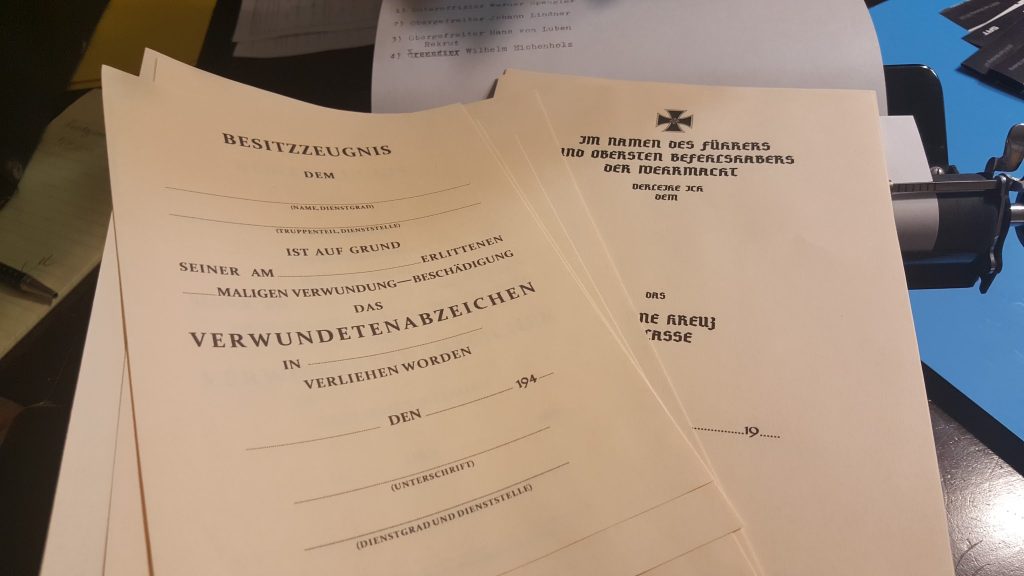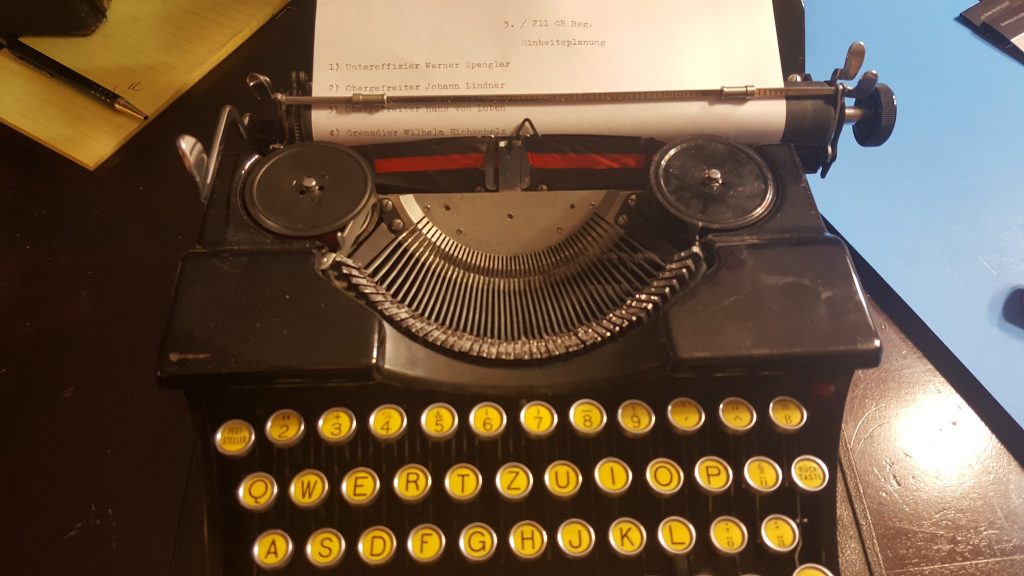- Written by Grenadier Dietrich Lindemann
Well before the invasion of Poland, the Third Reich had raised, armed, and equipped thirty-five infantry divisions of over 10,000 men each. Over time, all branches of the Wehrmacht and Waffen SS would go on to raise multiple divisions of troops at a time, in a series of recruitments called aufstellungswelle, simply translated as waves. These waves forced civilians into a thoroughly rigorous multi-week training regimen that built upon the centuries of Prussian military tradition of excellence and expertise. It was these troops that emerged from this training that would go on to conquer Poland, France, the Low Countries, the Nordic Countries, and the nations of the Balkans before descending into the largest land invasion in history with Operation Barbarossa.
The Germans had been planning these recruiting drives deliberately for years. The Germans of 1939 wanted to avoid the mistakes made in 1914. With the outbreak of World War One, millions of men transitioned from civilians to soldiers in the blink of an eye, forming into reserve, ersatz, and landwehr units. This time, draftees would be chosen based on a more complex and nuanced basis. Selection was typically based on profession and age in order to avoid economic interruptions.1
There were three sections to German training. The first section focused on the duties of the soldier as an individual. This focused on how to march, facings, and basic weapons training, and evening lectures on Germany, German history, military semantics, and Nazi ideology. The second section emphasized the role of the soldier within the squad. This mandated specific weapons training such as with machine guns, mortars, etc. This also kicked off intermediate maneuver and squad-centered training. Last, the squad would then become part of the battalion. This consisted of battalion level coordination drills.
As with all stressful and demanding lifestyles, the perception and experience of the sixteen weeks of ausbildung lay in the eye of the beholder. Some soldiers found it wearisome and tiring while others seemed to enjoy the predictable day-to-day schedule. Service schedules themselves were also variable, as indicated by many different sources who have very different experiences.
Siegfried Knappe found himself in an artillery unit in October, 1936. His day began at 5am with stable duty and ended “when we all fell into bed, exhausted, at 10 o’clock”2 Guy Mouminoux was drafted into a motorized unit and spent his training in eastern Poland.
He recalls also waking up at 5am for the first two weeks.3 Others, like 2nd Company 570th Abteilung were able to sleep in until 6am; their “lights out” was listed as 10pm.4 Walther Schminke joined the 2nd SS Division Das Reich in 1941 and spent the next few weeks also waking up at 6am. Clearly these variations naturally depended on a variety of factors, but in the end were dictated by the officer in charge of the camp or unit.
Regardless of the waking hour, the recruits were routinely awakened by a non-commissioned officer, typically a Feldwebel or corporal. They would race to the bathrooms, claim a sink, and begin washing various parts of the body including their face, hair, necks, arms, and armpits.5 They would also brush their teeth before returning to their toiletries in order to dress, make their beds, and tidy their barracks room before having breakfast.
In the making up and cleaning of the barracks, the troops were being instilled with the Germany Army concept of Barracks Training. This enforced the ideals of cleanliness in person, and in general detail-oriented performance at the squad and platoon level. Beds were made with the mattresses flipped up in order to air out the sheets.
Breakfast was often light, typically coffee and bread with or without various spreads such as honey, jellies, etc. After a few minutes of brief peace, the day began with either a parade or physical activity such as calisthenics. Afterwards, recruits spent much of the later mornings with weapons familiarization and training. Private Mouxminoux’s unit undertook lengthy marches to get to their weapons training ground, accomplishing two birds with one stone. Sometimes this timetable was completely mixed – Bruce Quarrie cites porridge and mineral water as the quintessential breakfast of the Waffen SS trainee.6
Weapons training was naturally extensive. All recruits began with dry fire. This was then expanded to firing from easiest positions to the hardest – prone, kneeling, and standing respectively. Every shot was observed by an NCO and every round sent downrange accounted for by the company clerk. Eventually, the best shots were sent into machine gun training. In this method, the soldiers gave themselves their own roles within the squad.7
Lunch was considered the largest meal of the day and was usually accompanied by at least an hours break in festivities. Lunch meals varied and could be just about anything, but one soldier said they were always “excellent, filling, and well cooked”.8
Mouminoux was apparently very adept at avoiding extra details: “all the Sergeant-instructors have jumped on these greenhorns… there is no question of going down to the courtyard [where the sergeants are]; they would only send us on fatigue… Up to that moment though, it is quite amusing to look down at the frenzied maneuvers of the greenhorns under a torrent of abuse.”9 Siegfried Knappe also had similar experiences with overzealous NCOs. Unteroffizier Max Krall was a prodigious 23 year old who’s expectations of perfection, such as re-teaching his men how to walk. Stabsgefreiter Weizsacker, one of Krall’s subordinates, was even worse. On Christmas Eve, Weizsacker had his men clean up the straw of the horse stable with their bare hands. The cause for the punishment was because his men looked up from their pitchforks during stall duty. Knappe swore to never treat his men the same way once he made NCO.10 Another soldier was made to carry the “punishment pack” for several hours. Weighing in at 80 pounds, it didn’t take long for the soldier to need “all my willpower to keep my knees from buckling… I learned that a good soldier does not cross the barracks square with his hands in his pockets.”11
As unfair as these Spartan ideals of perfection seemed, good behavior was rewarded as well as perceived slights were punished. Bernhard Teicher was a young conscript who was assigned to the position of MG1. As a machine gunner, part of his second section of training – of the soldier within the squad – was target practice with live ammunition. Teicher was so accurate that the target was very nearly destroyed by his MG34. Teicher earned a weekend pass to visit home for his achievement.12
Tactical training usually came in the midterms of the 16 week training. Recruits were often lectured in classrooms and shown chalk drawn illustrations of situations, maneuvers, attacks, and defenses. Then the men took to the field to practice – the NCOs their leadership and coordination, and the men their training. Karl Pichler recalled one of his first lessons as part of the 2nd SS Division “Das Reich”. Their unit was marched to a newly fertilized field full of cow and pig manure. They were instructed of the “enemy position” in the trees on the other side of the field and the objective to capture it. As the exercise began, the SS men ambled forward and carefully laid themselves onto the cleanest patch of grass possible. Suddenly, the office explained a new development to the exercise – that artillery has opened and is pounding the ground to their front; the soldiers must now roll towards the flank while lying. Pichler recalled that
“we returned to the barracks stinking from the filth which encrusted our uniforms. But our officer marched at our head as proud as a Spaniard, as if we had just won a battle. Before he dismissed us he spoke a few words. ‘Lads, think of this. If we were under fire you would not have time to find a nice place to fling yourself down. You would hit the deck quickly, irrespective of whether it was a field of flowers or a pile of shit.’ He was right of course.”13
Aside from tactics, field training included learning and mastering directional skills using maps, compasses, and the night sky. Marches with assault packs as well as tornisters became more and more routine. Regulation bunkers and trenches were constructed, demolitions, grenades, and heavy weapons were trained upon, and the troops became more accustomed to not only their own roles, but also the role of their immediate superior.
Evenings were relatively peaceful. Soldiers returned to their barracks or housing and settled into the ritual of weapons and uniform cleaning, or even repair. Blouses were brushed, boots were re-polished and cleaned, socks were darned, and helmets were exchanged for garrison caps. Around 5pm, final orders were issued or regulations were read in the final parade of the day. Afterwards, the evening meal was issued. Although lighter than lunch, it was still expected to be filling. Curfew or “lights out” was usually around 10pm depending upon circumstance and the desires of the post commander.
And so began the experience for millions of young men who would foray headlong into the deadliest war in human history. Although the days were lengthy to the point that so many memoirs and journals exclaim the routine exhaustion of basic training, nothing could prepare them for the real trials of combat. Such was the shock at the orders of the unit to the front that Mouminoux recalls the paling faces of the company when they actually received their weapons and winter uniforms. “Certainly we can all be excused for this: no one in the company is more than eighteen… Laus our feldwebel, is there, also helmeted and fully equipped. At his side he carries a long automatic in a black leather sheath, which gleams in the rain. We are all silent. The order to move out sounds like the abrupt blast of an express train’s whistle: ‘Achtung! Rechts um. Raus”!14
Our thanks to Grenadier Dietrich Lindemann for this exceptional article!
1 US War Department, “Handbook on German Military Forces”, 41.
2 Siegfried Knappe, “ Soldat: Reflections of a German Soldier, 1936-1949”, 104.
3 Guy Sajer, “The Forgotten Soldier”, 6
4 Chris Pittman, “Dienstplan”, https://festung.net/dienstplan-daily-duty-plan-for-wehrmacht-training/ 5 W. Reibert, “Der Dienstunterricht im Heere”, 63.
6 Bruce Quarrie, “The Waffen SS Soldier” 1940-1945, 21.
7 David Westwood, “German Infantryman 1933-40”, 17-20.
8 Walther Schmenke, “Errinerungen an Meine Diesntzeit in der Waffen SS”
9 Sajer, 6-7.
10 Knappe, 107
11 Westwood, “German Infantryman”, 15.
12 Bernhard Teicher, “For All It Was Worth”, 130-131.
13 James Lucas, “Das Reich: The Military Role of the 2nd SS Division”, 21.14 Sajer, 11.

